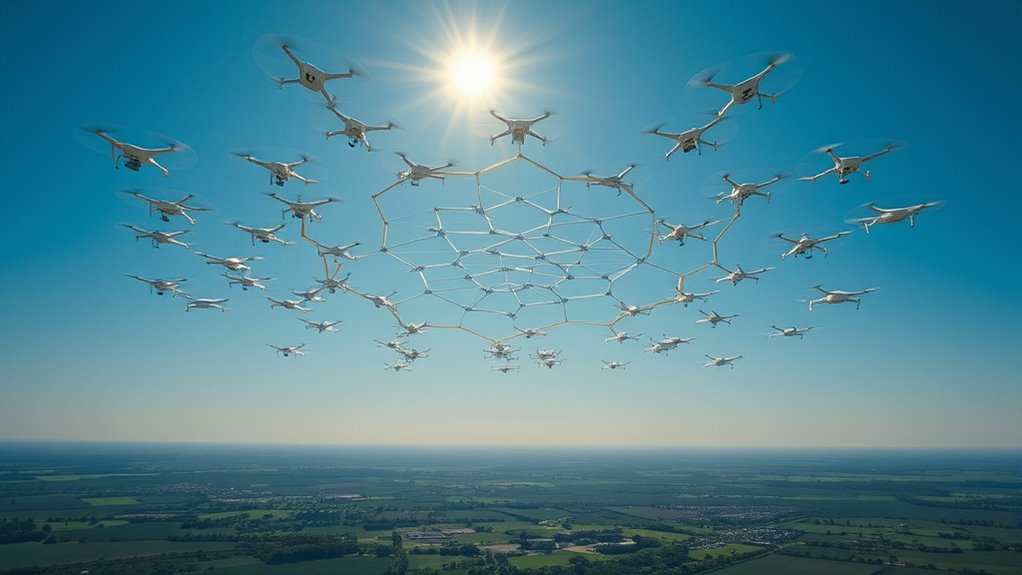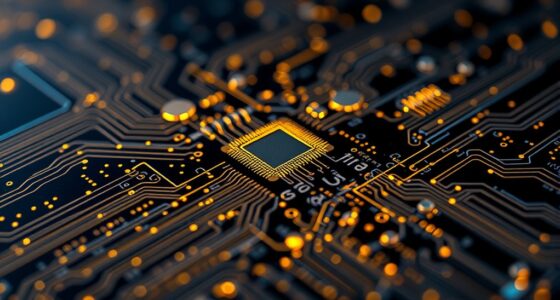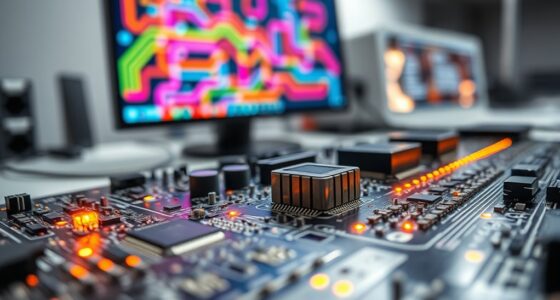Autonomous drone swarms use decentralized control algorithms inspired by nature, like ant colonies and bird flocks, to coordinate without central commands. Each drone makes decisions based on local information, enabling the entire system to work together seamlessly. This approach increases resilience, flexibility, and scalability, allowing the swarm to adapt to obstacles and failures autonomously. If you want to discover how these clever algorithms enable such impressive coordination, you’ll find more insights ahead.
Key Takeaways
- Decentralized algorithms enable individual drones to make local decisions based on shared information, facilitating autonomous coordination.
- Swarm intelligence principles inspire simple, rule-based interactions that lead to emergent, efficient collective behaviors.
- Coordination algorithms balance exploration, formation maintenance, and obstacle avoidance through local communication protocols.
- Self-organizing systems enhance resilience, allowing drone swarms to adapt and reconfigure dynamically amid failures or environmental changes.
- Nature-inspired designs promote scalable, robust, and flexible drone swarm operations without reliance on centralized control.

Have you ever wondered how drone technology is transforming the way we approach complex tasks? It’s especially fascinating when you consider autonomous drone swarms, where multiple drones work together seamlessly without constant human oversight. At the core of this innovation is the concept of decentralized control, which allows each drone to operate independently while still contributing to the group’s overall goal. Unlike traditional systems that rely on a central command, decentralized control distributes decision-making across the swarm, making the entire network more resilient, adaptable, and scalable. This approach guarantees that if one drone encounters a problem or fails, the rest can continue their mission without disruption.
Decentralized control in drone swarms ensures resilience, adaptability, and seamless operation without central oversight.
Swarm intelligence plays a critical role in enabling these autonomous groups to coordinate effectively. Inspired by nature—think of ant colonies or bird flocks—swarm intelligence allows each drone to make local decisions based on simple rules and shared information. These local interactions lead to emergent behaviors that are remarkably efficient and flexible. For example, a drone might detect an obstacle and communicate its position to neighbors, prompting the entire swarm to adapt their formation or route dynamically. Because each drone processes information locally and shares it with nearby units, the swarm collectively exhibits sophisticated behaviors without needing a central controller. This decentralized, self-organizing process is what makes drone swarms so powerful for tasks like search and rescue, environmental monitoring, or infrastructure inspection.
Developing effective coordination algorithms for autonomous drone swarms involves programming these local decision rules and communication protocols carefully. Engineers design algorithms that enable drones to balance exploration and exploitation, maintain formations, or adapt to changing environments—all through simple, decentralized interactions. These algorithms rely heavily on swarm intelligence principles, where the collective behavior arises from the interactions of individual units following straightforward rules. By focusing on decentralized control, the system becomes highly robust: if some drones are lost or malfunction, the remaining units can reorganize and continue their mission without needing external commands. This resilience is key for deployment in unpredictable or hazardous environments. Additionally, understanding multi-agent systems enhances the development of these algorithms, ensuring they are scalable and reliable.
In essence, the beauty of autonomous drone swarms lies in their ability to operate collectively through decentralized control, guided by swarm intelligence. You can think of these algorithms as the invisible threads weaving individual drone actions into a cohesive, intelligent whole. This synergy allows for rapid, flexible responses to complex tasks that would be challenging for a single drone or a rigid, centrally controlled system. As technology advances, these coordination algorithms will only become more sophisticated, *opening* new possibilities for autonomous operations that are efficient, resilient, and adaptable—just like nature’s most successful collective behaviors.
Frequently Asked Questions
How Do Drones Communicate Securely Within a Swarm?
You guarantee secure communication within a drone swarm by implementing encrypted communication and secure protocols. These methods prevent unauthorized access and data breaches, keeping your drone data safe. You can use encryption standards like AES or RSA to protect messages, while secure protocols such as TLS or DTLS establish trusted channels. By doing so, you maintain the integrity and confidentiality of your drone communications, ensuring smooth and secure coordination across the entire swarm.
What Are the Energy Consumption Implications of Swarm Coordination?
Imagine a well-oiled machine—your drone swarm’s energy use is just as critical. When you focus on coordination algorithms, you influence battery efficiency and power management. Efficient algorithms minimize communication and processing, conserving energy. Poorly designed ones drain batteries faster, reducing flight time. By optimizing these algorithms, you guarantee your drones operate longer, making energy consumption a strategic advantage rather than a limitation in your mission’s success.
Can Drone Swarms Adapt to Changing Environments in Real-Time?
You can design drone swarms to adapt to changing environments in real-time by using adaptive algorithms and environmental sensing. These technologies allow each drone to process new data instantly, adjusting their behavior accordingly. This means your drone swarm can navigate obstacles, respond to dynamic conditions, and optimize their operations on the fly. With continuous sensing and smart algorithms, you guarantee the swarm remains effective, flexible, and resilient in unpredictable situations.
How Scalable Are Current Coordination Algorithms for Large Swarms?
Scaling systems swiftly seems stunning, but scalability challenges can markedly slow down coordination efficiency in large drone swarms. As swarms grow, algorithms often struggle to manage massive amounts of data and communication, leading to potential delays and coordination breakdowns. You need scalable solutions that streamline synchronization, guarantee seamless communication, and support expansion without sacrificing performance. Addressing these challenges is essential for deploying large, efficient, and effective drone swarms in complex environments.
What Are the Legal and Ethical Considerations for Autonomous Drone Swarms?
When considering autonomous drone swarms, you must address legal and ethical issues like privacy concerns and accountability issues. You’re responsible for ensuring that data collected doesn’t infringe on individuals’ privacy and that the drones’ actions comply with laws. You also need clear accountability, so it’s evident who’s responsible if something goes wrong, preventing misuse and protecting civil liberties while deploying these advanced systems.
Conclusion
You might think autonomous drone swarms are just about technology, but their true power lies in coordination algorithms that mimic nature’s harmony. These systems prove that collective intelligence can surpass individual capabilities, revealing how simple rules lead to complex, effective behaviors. As you explore their potential, remember that collaboration—whether in drones or humans—often open up solutions unreachable alone. Embrace this insight, and you’ll see how unity fuels innovation and unblocks new possibilities.









